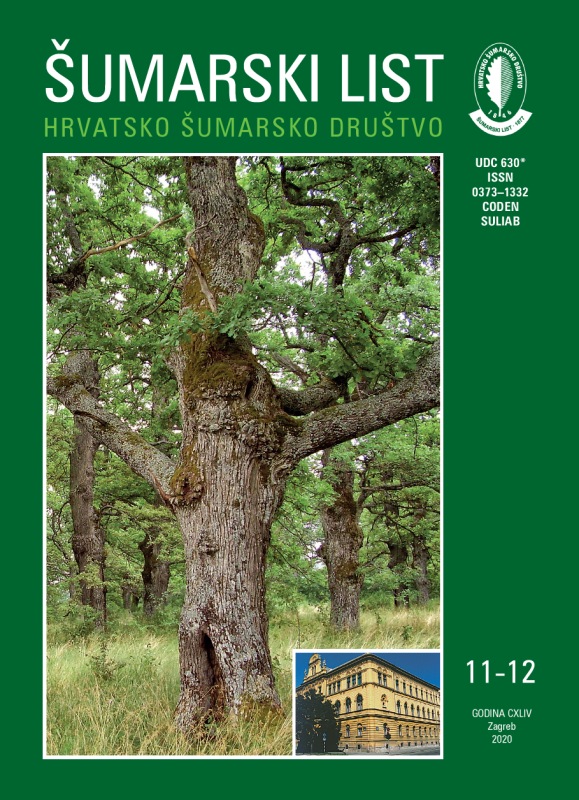
broj: 11-12/2020
pdf (5,77 MB) |
|
||||||||||||||
| RIJEČ UREDNIŠTVA | ||
| Uredništvo | ||
| The construction of the Danube – Sava canal and the EU Green transition pdf HR EN | 537 | |
| IZVORNI ZNANSTVENI ČLANCI | ||
| Igor Poljak, Joso Vukelić, Antonio Vidaković, Marijan Vuković, Marilena Idžojtić | UDK 630* 164 +165 (001) https://doi.org/10.31298/sl.144.11-12.1 | |
| Variability of the populations of scots pine (Pinus sylvestris L.) in the northwestern part of Mala Kapela according to the morphological characteristics of the needles and cones pdf HR EN | 539 | |
| Mario Slatki, Jelena Kralj | UDK 630* 148.2 + 653 (001) https://doi.org/10.31298/sl.144.11-12.2 | |
| Habitat selection of secondary hole-nesting birds in riverine forests along Drava river in Croatia pdf HR EN | 551 | |
| Murat Kose, Caglar Ugurlu, Omer Oncul, Fatih Demirci, Ilker Angin | UDK 630* 164 (001) https://doi.org/10.31298/sl.144.11-12.3 | |
| The use of sewage sludge and diatomite as growing medium in scots pine (Pinus sylvestris L.) seedling production and evaluation of its land performance pdf HR EN | 559 | |
| Amina Mašić | UDK 630* 969 (001) https://doi.org/10.31298/sl.144.11-12.4 | |
| Women in forestry in Bosnia and Herzegovina pdf HR EN | 565 | |
| A. Pilipović, M. Drekić, S. Stojnić, N. Nikolić, B. Trudić, M. Milović, L. Poljaković-Pajnik, M. Borišev, S. Orlović | UDK 630* 161 (001) https://doi.org/10.31298/sl.144.11-12.5 | |
| Physiological responses of two pedunculate oak (Quercus robur L.) families to combined stress conditions – drought and herbivore attack pdf HR EN | 573 | |
| Vladan Popović, Aleksandar Lučić, Ivona Kerkez Janković, Ljubinko Rakonjac, Saša Bogdan | UDK 630* 164 + 232.3 (001) https://doi.org/10.31298/sl.144.11-12.6 | |
| Variations in fruit traits of wild cherry (Prunus aviumL.) provenances in Serbia pdf HR EN | 585 | |
| Summary Natural wild cherry populations in Serbia are a part of the southern border of this valuable forest tree species distribution range. The survival of these marginal provenances in Serbia as well as in the wider region is threatened by climate change, small population sizes, low competitiveness, etc. Therefore, it is recommended to artificially assist population regeneration while increasing their genetic diversity. Although knowledge of the amount and pattern of the specie’s genetic diversity is a prerequisite for its effective conservation and use, related research in the region is scarce. The main goal of this study was to determine the amount and pattern of phenotypic variability of natural wild cherry populations in Serbia. Possible link between revealed pattern of phenotypic variability and genetic differentiation of the provenances was discussed. Fruits were collected in nine natural populations. Ten morphological traits of the fruits were measured, and average germination rate of the provenances was assessed. The least variable trait was the fruit width (CV = 6.2%), while the most variable trait was the petiole thickness (CV = 29.4%). Analysis of variance revealed significant among-provenance variation for investigated fruit characteristics (p <0.01; α = 0.05), except for the petiole thickness (p = 0.92). Although variability among provenances was significant, the level of within-population variability was much higher (41.2-52.1%) than among-provenance differentiation (5.3-15.2%). The pattern of among-provenance variation was determined by a correlation analysis between provenance mean values and their climatic-geographical variables, whereby fruit thickness and petiole length proved to be useful diagnostic traits. Mean fruit thickness was significantly and positively correlated with altitude (R = 0.69; p = 0.04), annual precipitation as snow (R = 0.80; p = 0.01), and annual degree-days below 0 °C (R = 0.70); p = 0.04). The average petiole length was significantly and negatively correlated with the annual precipitation as snow (R = -0.69; p = 0.04), while it was positively correlated with annual heat to moisture index (R = 0.71; p = 0.03). The results revealed an ecoclinal pattern of phenotypic differentiation among the provenances due to their habitat’s altitude and other ecological variables closely related to altitude. Although this study basically dealt with phenotypic variability of wild cherry fruits originating from natural populations, the results indicate likelihood for genetic differentiation of the provenances due to altitude. This likelihood provides the basis for recommending vertical seed zonation, as well as congruent use of reproductive material for assisted restoration of wild cherry populations in Serbia. However, to confirm this presumption of ecoclinal pattern of genetic differentiation, it is necessary to conduct analyses of various phenotypic traits in common garden experiments (e.g. provenance trials) as well as analyses of appropriate DNA markers. Key words: morphology; seed; phenotypic traits; provenance differentiation; ecocline. | ||
| PREGLEDNI ČLANCI | ||
| Damir Drvodelić, Milan Oršanić, Mirjana Grahovac-Tremski | UDK 630* 232.3 https://doi.org/10.31298/sl.144.11-12.7 | |
| Nursery production of forest fruit trees in nurseries of Croatian forests d.o.o. pdf HR EN | 597 | |


